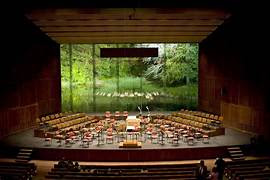Twentieth Century Orchestral Works in Lisbon
My first impressions of the classical music scene in Lisbon are very positive. I have seen three concerts, including by two I'll discus today done by tow of the three (!) major symphony orchestras in Lisbon. Each concert was well played and invigorating, easily matching the quality I am used to in NYC.
The Gulbenkian Orchestra programs 25+ concerts per year, mostly orchestral standards, and often involving a resident chorus. They play in a beautifully set hall, with a glass wall behind the orchestra, providing a beautiful forest backdrop to the music.
The orchestra skews to young Portuguese players (as do the other groups I have seen), likely reflecting a robust music training program in Portugal. The orchestra's conductors have changed frequently (I'm not sure why). The current (and new) conductor is the Finn Hanna Lintu, conductor of the Finnish National Opera. This leadership bodes well, as Finns like Esa-Pekka Salonen have been recently dominating the classical conducting market worldwide.
The orchestral program I saw included two Shostakovich pieces: the Cello Concerto and the 11th symphony ("The Year 1905"). The difficult and rhythmically taxing concerto (1959) was incisively played by the young first chair cellist of the orchestra, Marco Pereira. Often when orchestra members get a chance to play a concerto, the results are pleasant but a little pallid. After all, their week to week work is not solo abandon, but ensemble collaboration. This was not an issue here. Pereira tore into the piece (written for Rostropovich) with thrilling abandon. The piece had been well rehearsed, as the intricate coordination with the orchestra was right on point.
The 11th symphony (1957) was well played but suffered the limitations of Shostakovich's "event" symphonies. These works were commissioned by Josef Stalin to commemorate Soviet historical events, and include the symphonies #3 (The First of May), #7 (Leningrad) and #12 (The Year 1917). While colorful and (often) loud, these pieces were composed under duress. They were written to entertain the Politburo (and Soviet populace) and often lack the subtlety of other Shostakovich works (like the cello concerto). The 11th symphony depicts events of the "first" Russian revolution (pre-Bolshevik), and is most effective in the later movements depicting the conflict, in particular the relentless use of percussion to build tension. But the opening sounded too much like film music and, without a film, the first movement dragged on. Overall not a great piece.
The Orquestra Metropolitana de Lisboa is another talented youthful orchestra. They seem to specialize in diverse, non-standard repertory. The concert I saw featured three "concertos", played in an acoustically superb hall at the Coach Museum in Belém, home of a fabulous monastery and the presidential palace, and just west of Lisbon. In this venue, old Portuguese coaches surrounded the audience under a florid Baroque ceiling. Two of these concertos were by composers unknown to me. The first was a Concerto in D by Joly Braga Santos (1924-1988), considered by many as the finest 20th century Portuguese composer. This was my first exposure to his music, and this very entertaining concerto grosso (small ensembles alternating with the large orchestra) was crisp, contrapuntal, well structured, and had a style reminiscent of Brits Vaughn Williams or Frank Bridge, spiced with local musical color. I really liked the dark string chords of the opening. I looked him up and, yes, Santos did meet and study with Vaughn Williams in the 1940s! I'd like to hear more of his music.
The world premiere of the violin concerto by Portuguese contemporary composer António Chagas Rosa was less successful. Like many pieces of this century, it favored timbre and texture over structure, and I failed to follow any logical organization of the material, even simple things like the recurrence of themes.
The concert ended with the early (1949) Romanian Concerto of Romanian György Ligeti (1923-2006). Except for an uninspired first movement, the rest of the piece was dynamic, alternating rapid folk music akin to Bartok with glimpses into Ligeti's modernist, glistening atonality that was to blossom in the following decade. (You may know Ligeti from his "far out" music from outer space in the last part of 2001: A Space Odyssey). Kudos to the virtuosic playing of the strings and piccolo in the very rapid last movement, taken at breakneck tempo by conductor Pedro Neves. This is another great orchestra, with very adventuresome programming, and I look forward to regular attendance at their concerts.
So wow, I have already seen two well-executed "modern" concerts done by established groups, each with an appreciative audience. I think I will like it in Portugal. Criticultura lives!

Welcome to Lisbon and the classical music scene here! Glad you enjoyed your first couple of concerts.
ReplyDelete